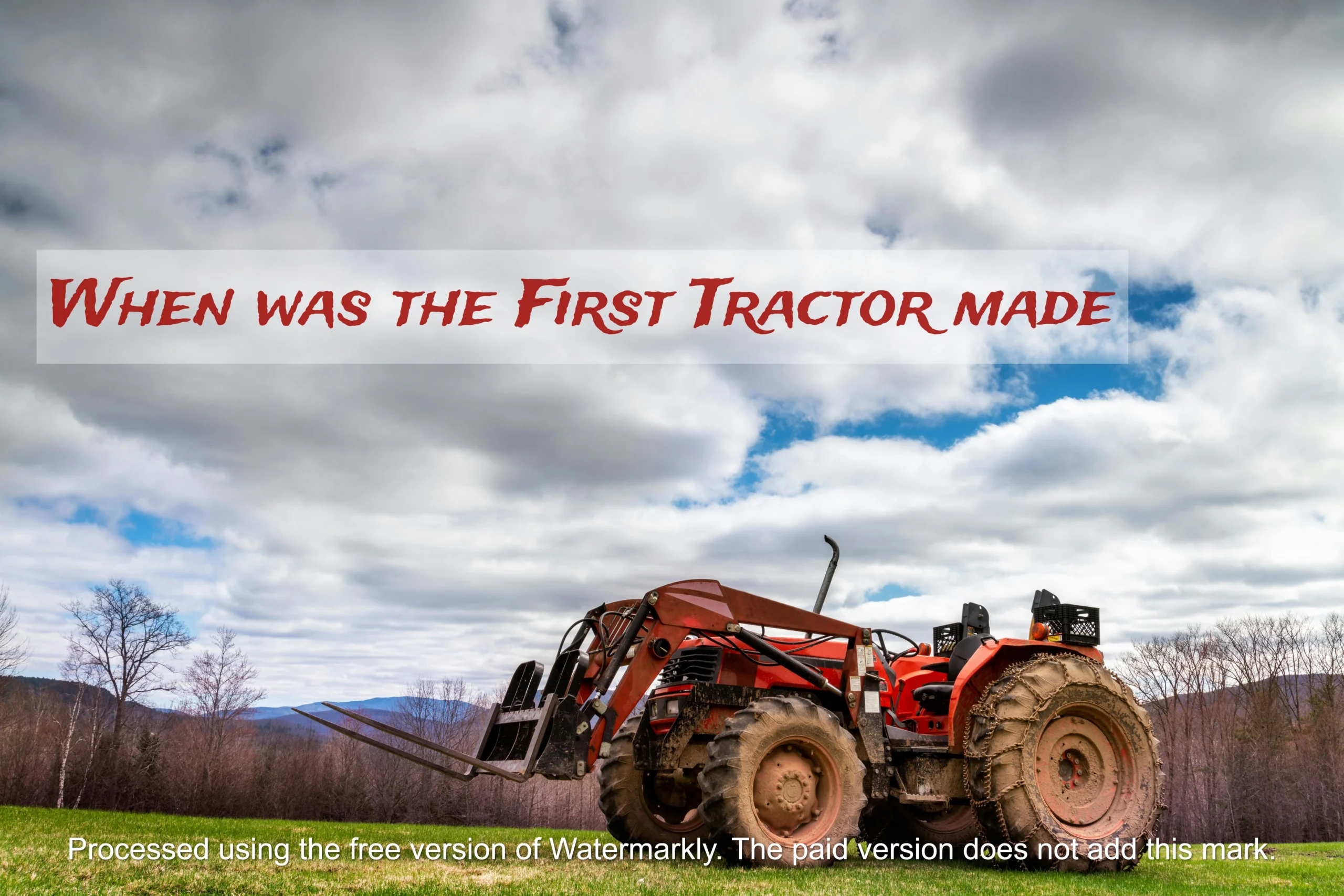The first tractor, known as the “gasoline-powered traction engine,” was developed by Charles Hart and Charles Parr in Charles City, Iowa, USA, in 1903. This tractor marked a significant shift in agricultural technology, replacing animal power with mechanized farming equipment. It revolutionized farming practices by increasing efficiency, productivity, and the scale of agricultural operations worldwide.
Introduction
Tractors are an indispensable part of modern agriculture, construction, and various other industries. These powerful machines have revolutionized the way we work the land, move heavy materials, and accomplish tasks that would otherwise be extremely labor-intensive or even impossible without their aid. But have you ever wondered about the origins of the tractor? When was the first tractor made, and who was responsible for this groundbreaking invention? In this article, we’ll delve into the fascinating history of tractors, tracing their evolution from the earliest prototypes to the sophisticated machines we know today.
The Early Beginnings: Precursors to the Modern Tractor
Steam-Powered Pioneers
The concept of a self-propelled, engine-powered vehicle designed for agricultural purposes can be traced back to the late 18th and early 19th centuries. The earliest known attempts at creating such a machine were steam-powered tractors, which were essentially modified versions of steam engines used in factories and railways.
One of the earliest examples of a steam-powered tractor was the “Portable Horse Mill” designed by Richard Trevithick in 1808. This contraption consisted of a stationary steam engine mounted on a chassis with wheels, allowing it to be moved from one location to another. While not truly self-propelled, it laid the groundwork for future developments in the field.
The Fowler Steam Plow Engine
In the 1850s, John Fowler, an English inventor and engineer, created the “Fowler Steam Plow Engine.” This massive machine was designed to pull a plow across fields, significantly reducing the manpower and animal labor required for farming. The Fowler Steam Plow Engine was a successful innovation, and it found widespread use in Britain and other parts of the world.
Early Internal Combustion Engines
While steam-powered tractors were a significant step forward, they were limited by the need for a constant supply of water and fuel, as well as their overall size and weight. The development of internal combustion engines in the late 19th century paved the way for more compact and efficient tractors.
The Waterloo Boy
In 1892, John Froelich, an American inventor and blacksmith, created what is widely considered the first gasoline-powered tractor. Known as the “Waterloo Boy,” this tractor was a small, single-cylinder machine that could be used for plowing and other agricultural tasks. While not an immediate commercial success, the Waterloo Boy laid the foundation for future developments in internal combustion-powered tractors.
Early 20th Century Innovations
As the 20th century dawned, several companies and inventors began experimenting with different designs and configurations for tractors, each seeking to improve upon the existing technology.
The Aultman-Taylor Tractor
In 1904, the Aultman-Taylor Company of Mansfield, Ohio, introduced the “Aultman-Taylor Tractor.” This machine featured a two-cylinder engine and a unique design that allowed it to be steered using the rear wheels. The Aultman-Taylor Tractor was a commercial success and was widely used in various agricultural applications.
The Ford Model B Tractor
In 1917, Henry Ford, the legendary American industrialist and founder of the Ford Motor Company, unveiled the Model B Tractor. This machine was designed to be affordable and reliable, making it accessible to a wider range of farmers. The Model B Tractor featured a four-cylinder engine and was capable of performing a variety of tasks, including plowing, harrowing, and cultivating.

The Rise of Modern Tractors
The Farmall Tractor
In the 1920s, the International Harvester Company (now known as Navistar International Corporation) introduced the Farmall tractor, which would go on to become one of the most iconic and successful tractors in history.
The Farmall Regular
The first model in the Farmall line was the “Farmall Regular,” which was released in 1923. This tractor featured a unique design with a compact, high-clearance body and a powerful four-cylinder engine. The Farmall Regular was designed to be versatile, capable of handling a wide range of agricultural tasks, from plowing to cultivating and even hauling.
The Farmall F-20
In 1924, International Harvester followed up with the Farmall F-20, which improved upon the original design with a more powerful engine and a variety of new features. The F-20 was an instant success and helped cement the Farmall brand as a leader in the tractor market.
John Deere and the Rise of Modern Tractors
While International Harvester was leading the way with the Farmall line, another company was also making significant strides in tractor development: John Deere.
The John Deere Model D Tractor
In 1923, John Deere introduced the Model D Tractor, which was designed to compete directly with the Farmall Regular. The Model D featured a two-cylinder engine and a unique “power-trol” system that allowed the operator to adjust the tractor’s speed and power output on the fly.

The John Deere Model B Tractor
In 1935, John Deere released the Model B Tractor, which would go on to become one of the company’s most successful and iconic models. The Model B featured a powerful two-cylinder engine and a sleek, streamlined design that was both functional and aesthetically pleasing.
Advancements in Tractor Technology
As the 20th century progressed, tractor technology continued to evolve at a rapid pace, with manufacturers introducing new features and innovations to improve efficiency, performance, and operator comfort.
Hydraulic Systems
One of the most significant advancements in tractor technology was the introduction of hydraulic systems. These systems allowed for the precise control of implements and attachments, making it easier to perform a variety of tasks with a single machine.
Improved Ergonomics and Comfort
As tractors became more powerful and capable, manufacturers also focused on improving ergonomics and operator comfort. This led to the introduction of features such as air-conditioned cabs, adjustable seats, and improved visibility.
Precision Agriculture and GPS Technology
In recent decades, the integration of GPS technology and precision agriculture techniques has further revolutionized the way tractors are used. Farmers can now use GPS-guided systems to precisely control the application of inputs such as fertilizers and pesticides, reducing waste and improving efficiency.

The Modern Tractor: A Powerhouse of Innovation
Today’s tractors are highly advanced machines, incorporating cutting-edge technologies and features that would have been unimaginable to the pioneers who first developed these vehicles. Modern tractors are equipped with powerful engines, advanced transmission systems, and a wide range of implements and attachments designed for specific tasks.
One of the most notable developments in modern tractor technology is the use of computer systems and electronic controls. These systems allow for precise monitoring and adjustment of various parameters, such as engine performance, fuel efficiency, and implement control.
In addition to their impressive capabilities, modern tractors are also designed with operator comfort and safety in mind. Features such as air-conditioned and soundproofed cabs, ergonomic seating, and advanced safety systems ensure that operators can work efficiently and comfortably, even in challenging conditions.
Autonomous and Semi-Autonomous Tractors
As technology continues to advance, the agricultural industry is also exploring the potential of autonomous and semi-autonomous tractors. These cutting-edge machines are designed to operate with minimal or no human intervention, utilizing advanced sensors, cameras, and GPS systems to navigate fields and perform tasks with incredible precision.
While fully autonomous tractors are still in the developmental stages, semi-autonomous systems are already being implemented in many modern tractors. These systems can assist with tasks such as steering, implement control, and even field mapping, reducing the workload on operators and improving overall efficiency.
Sustainable Tractor Technologies
In addition to advancements in automation and precision agriculture, manufacturers are also focusing on developing more sustainable and environmentally friendly tractor technologies. This includes the use of alternative fuel sources, such as biofuels and electric powertrains, as well as the incorporation of energy-efficient systems and materials.
One example of a sustainable tractor technology is the use of hybrid powertrains, which combine traditional internal combustion engines with electric motors and battery systems. These hybrid systems can significantly reduce fuel consumption and emissions while maintaining the necessary power and performance for agricultural applications.
Connectivity and Data Analytics
Another emerging trend in modern tractor technology is the integration of connectivity and data analytics. Many new tractors are equipped with advanced telematics systems that allow for remote monitoring and data collection, enabling farmers and fleet managers to track performance, diagnose issues, and optimize operations.
Furthermore, the vast amounts of data collected by modern tractors can be analyzed using sophisticated algorithms and machine learning techniques, providing valuable insights into soil conditions, crop health, and overall farm productivity. This data-driven approach to agriculture is helping to revolutionize the industry, enabling more informed decision-making and ultimately improving yields and profitability.
Table: Tractor Evolution Timeline
| Year | Milestone |
|---|---|
| 1808 | Richard Trevithick designs the “Portable Horse Mill,” an early steam-powered tractor prototype. |
| 1850s | John Fowler creates the “Fowler Steam Plow Engine,” a successful steam-powered tractor used for plowing fields. |
| 1892 | John Froelich invents the “Waterloo Boy,” considered the first gasoline-powered tractor. |
| 1904 | The Aultman-Taylor Company introduces the “Aultman-Taylor Tractor,” featuring a two-cylinder engine and rear-wheel steering. |
| 1917 | Henry Ford unveils the Model B Tractor, designed to be affordable and reliable for farmers. |
| 1923 | International Harvester introduces the Farmall Regular, a compact and versatile tractor that becomes a commercial success. |
| 1923 | John Deere releases the Model D Tractor, featuring a unique “power-trol” system for adjusting speed and power output. |
| 1935 | John Deere’s Model B Tractor is released, becoming one of the company’s most iconic and successful models. |
| Late 20th Century | Advancements in hydraulic systems, ergonomics, and precision agriculture technologies are introduced. |
| Early 21st Century | Modern tractors incorporate computer systems, electronic controls, and advanced safety features. |
| Present Day | The development of autonomous, semi-autonomous, sustainable, and connected tractor technologies continues. |
Conclusion
The journey from the earliest steam-powered prototypes to the advanced, high-tech tractors of today has been a remarkable one. The evolution of tractors has not only transformed the agricultural industry but has also had a profound impact on various other sectors, enabling more efficient and productive operations in construction, mining, and more.
As we look to the future, it’s clear that tractor technology will continue to push boundaries, incorporating cutting-edge innovations in areas such as automation, sustainability, and connectivity. The tractors of tomorrow will be smarter, more efficient, and more environmentally friendly, helping to ensure a sustainable and productive future for agriculture and beyond.
FAQs
- What was the first tractor? The first tractor is generally considered to be the “Waterloo Boy,” invented by John Froelich in 1892. This small, single-cylinder, gasoline-powered tractor was designed for agricultural tasks such as plowing.
- Who invented the first modern tractor? While there were several important inventors and companies involved in the development of early tractors, the International Harvester Company is credited with introducing the first truly modern tractor, the Farmall Regular, in 1923.
- What was the significance of the Farmall tractor? The Farmall tractor, introduced by International Harvester in 1923, was a groundbreaking design that featured a compact, high-clearance body and a powerful four-cylinder engine. Its versatility and affordability made it a commercial success and helped establish International Harvester as a leader in the tractor market.
- How have modern tractors evolved from their early predecessors? Modern tractors have evolved significantly from their early predecessors, incorporating advanced technologies such as computer systems, electronic controls, precision agriculture technologies, and even autonomous and semi-autonomous capabilities. They are also designed with a strong emphasis on operator comfort, safety, and sustainability.
- What are some of the latest innovations in tractor technology? Some of the latest innovations in tractor technology include autonomous and semi-autonomous systems, hybrid and electric powertrains, advanced telematics and connectivity features, and the integration of machine learning and data analytics for precision agriculture applications.

